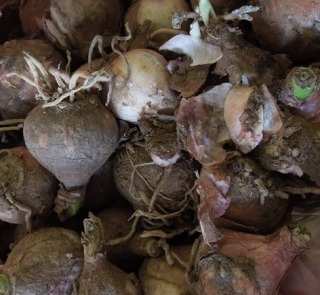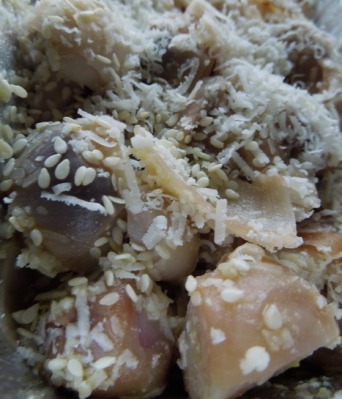And yes, wild blue hyacinth is my favorite bulb.
Not feeling the enthousiasm?
The bitter taste of bulbs (muscari comosum, Gr. volvoi) is much appreciated in Greece ever since classical times. They also had a good reputation as an aphrodisiac amongst ancient Greeks and Byzantines.
If you come across them in the farmer’s market, please buy them! It is really worth it to try them out. Clean them and if they are big cut a cross in the root base of each of them. Leave them for 2 seconds- 2 minutes in boiling water (the boiling time depends on their size). Then put them in a large bowl of water. Change the water every 3 hours for one day and one night. Drain the bulbs in a colander, put them in a jar, add some peppercorns and cover with good quality wine vinegar.
Serve them with virgin olive oil and garnish with chopped spring onions and dill or with chopped fresh garlic and mint. Their mildly bitter taste makes a truly wonderful combination with those flavorings.
In Crete, where you find a plethora of dishes based on foraged wild plants and roots, volvoi are cooked together with lamb, pork, snails octopus or cuttlefish.
But of all bulb recipes I have ever made, there is one really favourite that was worth my effort to set up its proportions. Philemon, the comic poet, suggests this preparation of bulbs in Deipnosophistae of Athenaeus: “Look, if you please, at the bulb, and see what lavish expense it requires to have its reputation — cheese, honey, sesame-seed, oil, onion, vinegar, silphium. Taken by itself alone it is poor and bitter.” Homemade goat cheese, thyme honey and a pinch of asafoetida powder, virgin olive oil, homemade wine vinegar, onion, sesame seeds and slightly bitter bulbs make something truly memorable.
ΓΙΑ ΕΛΛΗΝΙΚΑ ΕΔΩ




The same bulbs of Muscari comosum are known in Italy as “lampascioni” and are used more or less in the same way in the traditional cousine of Puglia and Basilicata regions of southern Italy.
Hi Luigi,
Are lampascioni also cooked together with meat or seafood?
Great info, I didn't know about hyacinth bulbs being traditional Greek food even though I'm Greek! Well at least I knew about Cretan bulbs with lamp.